Untitled Goose Game:
The main quests from Untitled Goose Game revolve around theft. So the development team created a goose, and a person, and some stuff the person cared about to steal – then they explored some environments and systems that would make it FUN to steal that stuff!
Much of the level design was done intuitively, inspired by BBC kids television. The garden level was modelled after Jake Strasser’s grandparents’ garden, and he ensured every aspect of the level was able to be messed with uniquely, segmented to give it a “playground” feel. Each bed serves a different function:
- High planters to hide behind
- Potato plant to hide inside of
- Dirt pile to get up high
- Plenty of vegetables to steal in different ways depending on size, shape, and location.
Initially, setting and context were SECONDARY to the game.
When the Untitled Goose Game demo was released and they started developing more locations, Strasser wanted to further push the English town aesthetic – so he did NOT start with greyboxing! Strasser felt that working in a totally abstracted way where spacial application of game design overrides everything else would make it more difficult to convert into a setting that authentically depicted the UK and its culture. Instead he researched the UK via Google Maps and discovered how the history of certain towns influenced its architecture and placements.
The level design was a dialogue between the source location and the level; a constant balancing act between research, game design, and environment art.
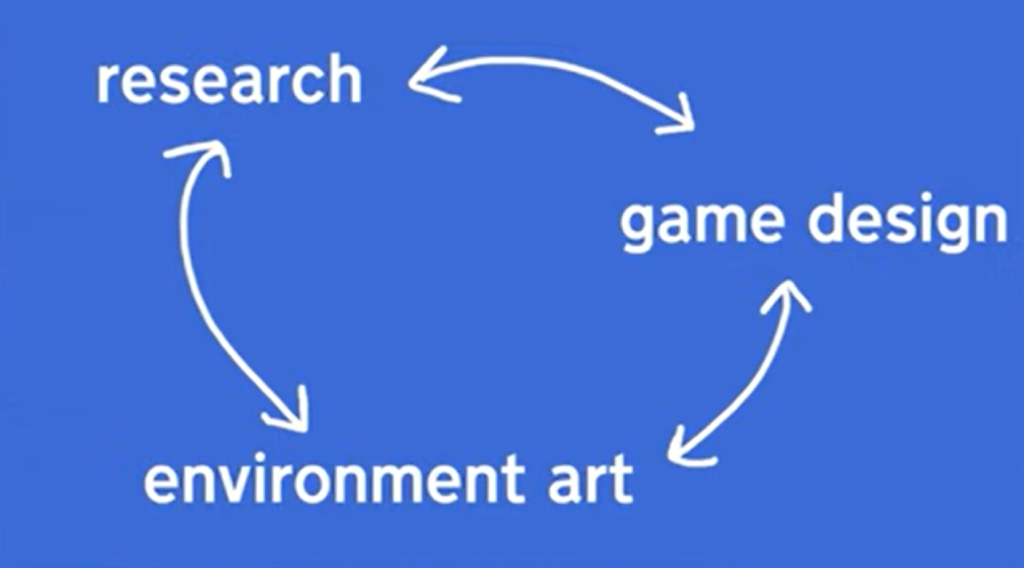
Example: The Shops
Research:
- Needed to location-scout a small, privately-run general store in a more commercial part of a village.
- Ended up being based on Thaxted! It was a commerical village with deep footpaths from where they ran a modern street down an old square, where people since began to set up stalls. The location fit perfectly into the needs of the game design.
Environment Art:
- Needed to convert the artstyle from something more pastoral and green to urban
- Everything in the level was taken from different year’s snapshots of the street in Thaxted. He modelled a fruit-and-veg and outdoor shelves from the shopfront picture of 2009; handtrucks and plants from the shopfront in 2014; and a nearby water pump, post office, and bench were added into the game.
Game Design:
- All game elements must happen outside, or be visible from outside, so stalls needed to be out on the street.
- Wanted the level to be an interplay between a dense shopping area and an open street
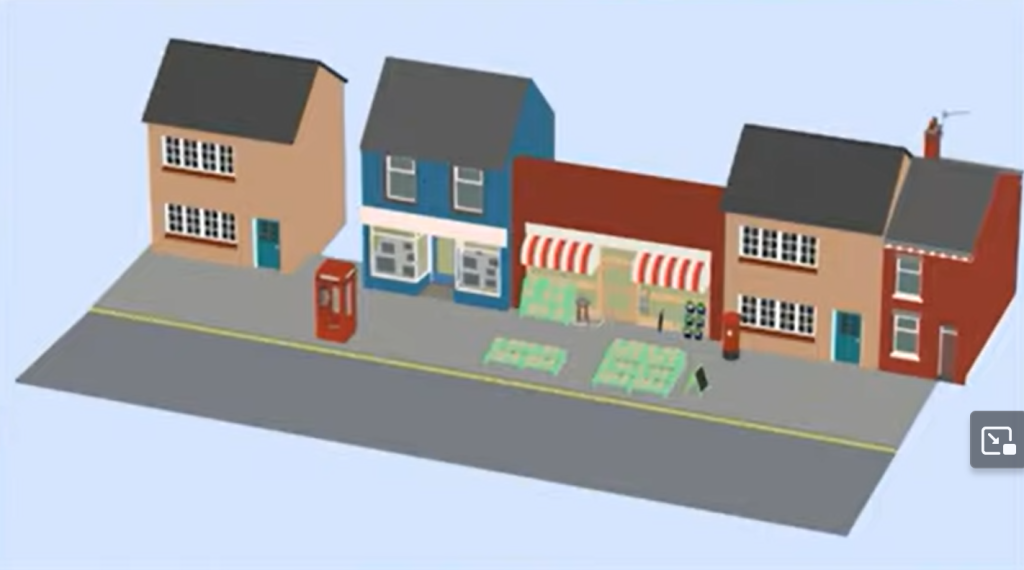

Personally what stood out to me when I played Untitled Goose Game was how tactile everything was. Anything could be displaced or broken, and everyone could be bothered, so much of the game was myself and my sibling running around trying to grab everything we could, and hatching schemes to steal things together.
One particularly memorable heist wasn’t even an in-game objective. We stole one of the anti-goose signs, and discovered we could clip ourselves onto the well’s edge with it. Obviously the next logical stage, being at a better angle to the sign now, was to try and maneouvre the anti-goose sign INTO the well. It was about fifteen minutes in the making of painful goose-step shuffling, trying to flip over the sign to drop it in. The moment it went, my sibling’s character TELEPORTED across the screen into the bushes, and the sign disappeared! It was magnificant.
Takeaways:
- Research, Environment Art, and Game Design are principles that feed into each other, not an itemized list to check off one-by-one.
- When designing a game around mischief, make EVERYTHING tactile. Players will want to experiment and amuse themselves, and it fulfills two opposite ends of player archetypes: socialisers and killers.
GDC 2025 (2021). Google Maps, Not Greyboxes: Digital Location Scouting for ‘Untitled Goose Game’. [online] YouTube. Available at: https://www.youtube.com/watch?v=tA-64QuWgLk [Accessed 10 Mar. 2025].
Stray:
Much of the enjoyment of playing Stray is getting to move around the world as a cat would. This means having highly realistic kitty movement mechanics, but it also means being able to do things you wouldn’t as a human! Cats can jump higher, move faster, and balance better than the average human can, and the levels have been designed with this in mind. Verticality is hugely emphasised in Stray, and as it’s also a principle I want to practice in Oh, Rats!, I ought to study how Stray creates its levels.
The best example of Stray using verticality and puzzle-solving elements is in Chapter 5, where the objective is to climb to the top of a building. I particularly like this part with the suspended beam, where you have to use a suspended beam to get across a gap; the beam points forwards, leading the eye to tell players where to go next, and the raised wall allows the player a good look at the next part of the level to figure out what to do.
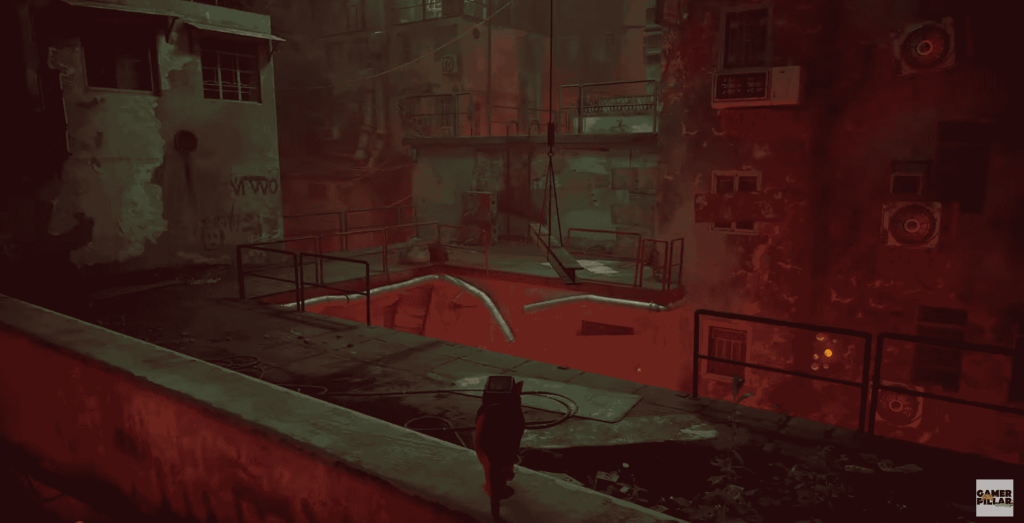
Another point is the clever use of physics to traverse and puzzle-solve. For example, hvaing to climb inside oil drums to roll them across, and using the momentum from jumping on suspended beams to reach another platform. I could implement this in Oh, Rats! with hanging baskets.
Stray also uses lines to guide players where to look. This is a common technique in paintings, but the use doubles in game design, where the place to look leads to the next part of the level. This is definitely something needed more of in Oh, Rats!, as I want to be able to guide players into triggering specific quests in the game, instead of them having to wander and explore randomly.
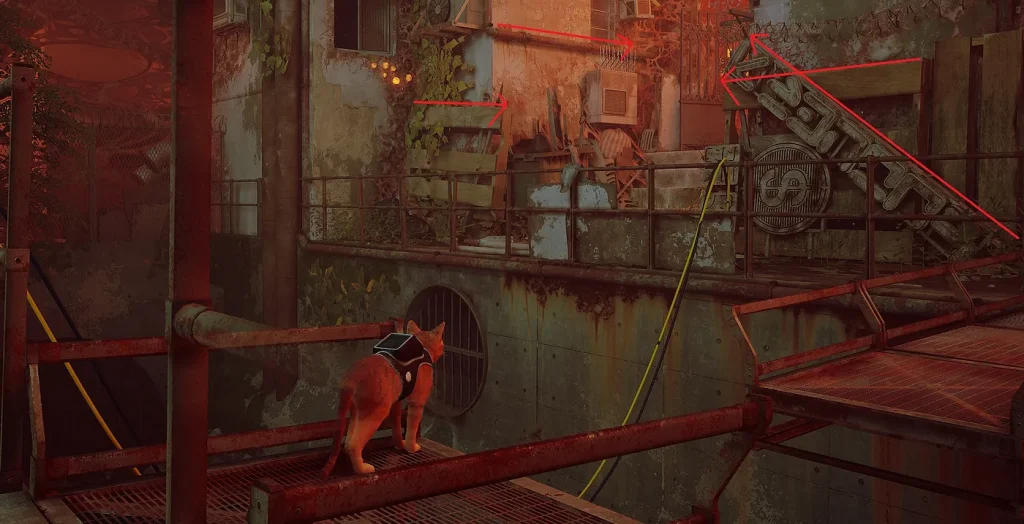
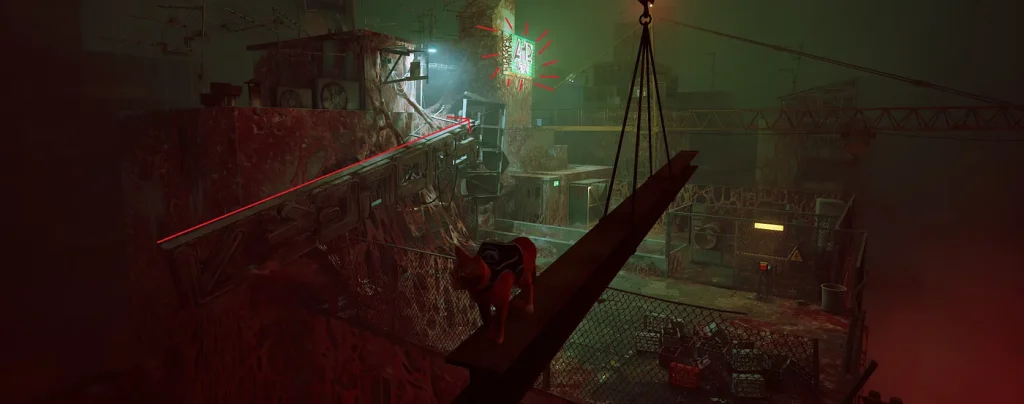
Lighting is additionally used to help players. Light acts as a beacon; players will be generally drawn to whatever area of the map is lit up. In Stray, different coloured lighting even indicates different types of objectives: the orange lights present the main story and the blue are side-objectives. For Oh, Rats!, this principle should be similar. Dark corners and shadowed areas should indicate easy places to hide in a hurry, while bright spots offer rewards but run the risk of getting caught.
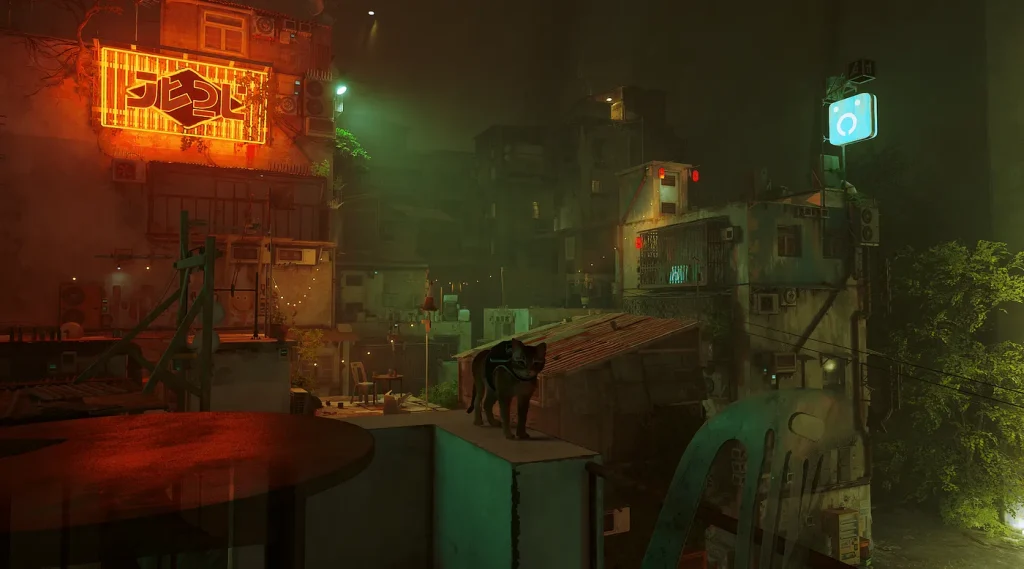
Finally, Stray uses cinematography to guide players around their levels. When the developers want the players to be amazed at the vast world stretching out before them, they don’t simply put them in that vast world. They put the character in a small space first, and have them climb out – THEN be amazed. It adds a little bit of storytelling!
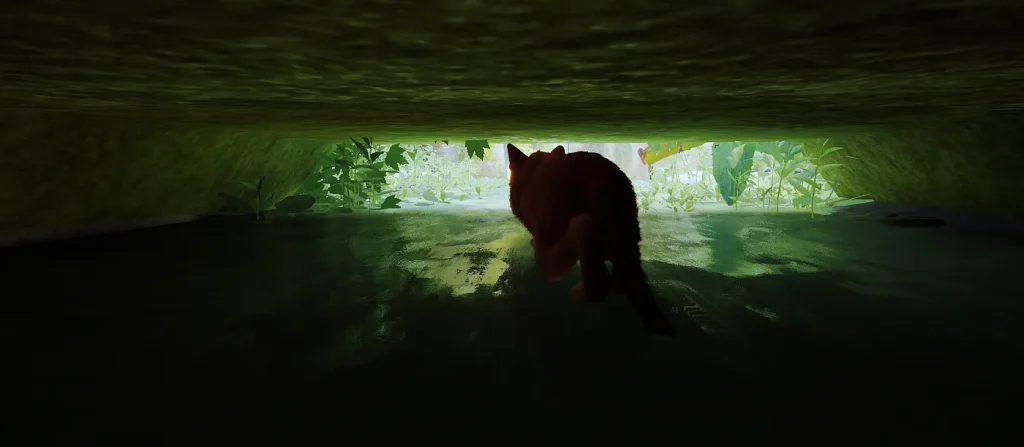
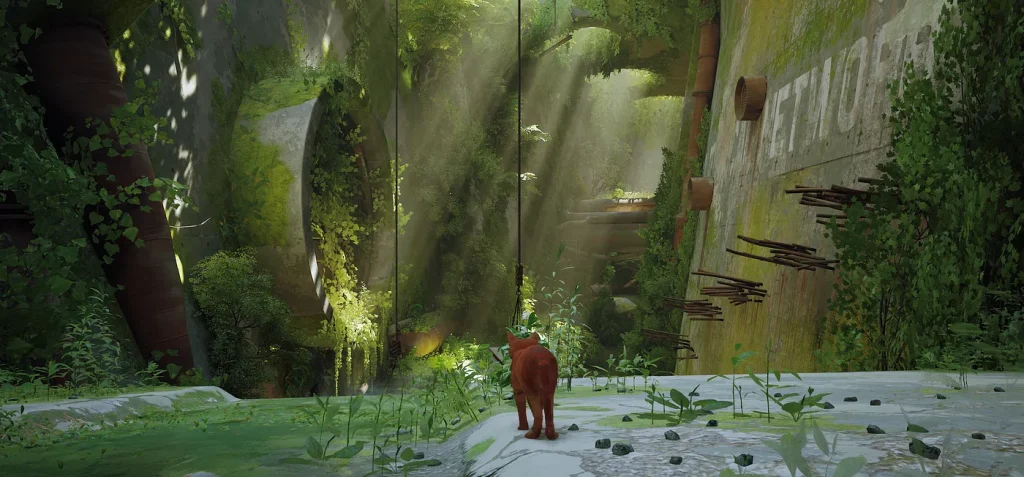
Takeaways:
- Create unique verticality by strategic prop placement, and use physics to your advantage!
- Use props to create lines and guide player’s eyes towards quests
- Use colour to guide players by having dark and light spots mean different things, and having different colours mean different things.
- Use storytelling and cinematography to create emotional reactions in players
Endres, A. (2024). Level Design Analysis of Stray – Austin Endres – Medium. [online] Medium. Available at: https://medium.com/@endresau/level-design-analysis-of-stray-7644e5a6f525.
Little Nightmares
Little Nightmares, like Stray, is a game with a lot of verticality and puzzle-solving, for all that it’s a sidescroller. It has a more cluttered appearance than Stray, with intriguing environments, and the puzzle premises are usually very good.
For example, in the DLC there is a pool-puzzle that takes place in the span of one room: you must retrieve and insert a crank left on an upper platform, and use the pool’s drain and refill mechanics to get yourself and this crank across with the help of a floating suitcase. It’s intuitive, the environment lends you clues (like the moonlight hitting the beams on the far right corner making it look like a ladder to reach the platform), and usually after a bit of analysis the player can then solve the puzzle with experimentation, and move onto its execution.
The Analyse -> Solve -> Execute structure is a good metric for creating puzzles in games. In this case, players spend some time analysing the room (exploring it; finding the slot where the crank should be; discovering the drain/refill button; using the ladder), and more time solving it (finding out how to get the crank into position using the drain/refill and suitcase). For games with a fast flow, more time should be spent in the analysis phase, and for games where you want players to feel more rewarded by puzzles, more time should be spent solving.

However, this is where the puzzle falters. The execution phase by far takes the longest. The button inputs have to be precise, and the environment hinders your pace – there is a beam blocking a direct jump to the suitcase, and to get past the door before it closes you HAVE to slide-dash. This is when gameplay starts to become frustrating. The players aren’t being engaged with analysis or solving, they have a dearth of skill that leads to repetition.
I believe that Oh, Rats! should have an emphasis on the analysis and solving elements – particularly the solving. Once players are familiar with the rooms, props, and mechanics, then analysis will lessen for the later puzzles. This element will also be reduced by the “Tasks” feature as, like Untitled Goose Game, we will give the players an itemized list of potential mischief they can get up to.
Takeaways:
- In the Analyse->Solve->Execute structure, as LITTLE time should be spent on execute as possible, because this runs the risk of watering down the exploration and puzzle elements to a frustrating skill-based slog
- The environment should inform, structure, and help the puzzles – NOT hinder the player
Saint (2022). What’s the identity of Little Nightmares? [online] YouTube. Available at: https://www.youtube.com/watch?v=IHlAMAW5Evo [Accessed 10 Mar. 2025].

Leave a Reply